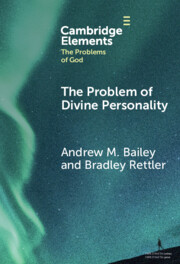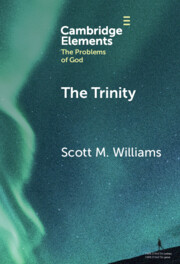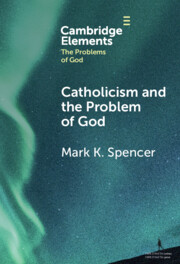105 results
Towards a grammar of theocentric belonging: Kilby, Tanner and beyond
-
- Journal:
- Scottish Journal of Theology , First View
- Published online by Cambridge University Press:
- 06 March 2025, pp. 1-11
-
- Article
- Export citation
1 - An Incarnational Theology
- from Part I - The Story of God
-
- Book:
- Constructing an Incarnational Theology
- Published online:
- 09 January 2025
- Print publication:
- 23 January 2025, pp 9-23
-
- Chapter
- Export citation
7 - God
- from Part III - Reconfiguring the Story
-
- Book:
- Constructing an Incarnational Theology
- Published online:
- 09 January 2025
- Print publication:
- 23 January 2025, pp 167-187
-
- Chapter
- Export citation

The Problem of Divine Personality
-
- Published online:
- 13 December 2024
- Print publication:
- 30 January 2025
-
- Element
- Export citation

The Trinity
-
- Published online:
- 09 December 2024
- Print publication:
- 16 January 2025
-
- Element
- Export citation
6 - Jesus and the Triune God
- from Part I - Origins
-
-
- Book:
- The New Cambridge Companion to Jesus
- Published online:
- 15 November 2024
- Print publication:
- 05 December 2024, pp 88-102
-
- Chapter
- Export citation
Question 11 - The Unity of God
-
- Book:
- Commentary on Thomas Aquinas's Treatise on the One God
- Published online:
- 23 November 2024
- Print publication:
- 21 November 2024, pp 155-175
-
- Chapter
- Export citation
No new problem for the Trinity: A reply to Mooney
-
- Journal:
- Religious Studies , First View
- Published online by Cambridge University Press:
- 20 November 2024, pp. 1-17
-
- Article
-
- You have access
- Open access
- HTML
- Export citation
Divine Contradiction: replies to critics
-
- Journal:
- Religious Studies / Volume 60 / Issue 4 / December 2024
- Published online by Cambridge University Press:
- 02 September 2024, pp. 717-735
- Print publication:
- December 2024
-
- Article
-
- You have access
- HTML
- Export citation
Divine contradiction: fascinating but unpersuasive
-
- Journal:
- Religious Studies / Volume 60 / Issue 4 / December 2024
- Published online by Cambridge University Press:
- 02 September 2024, pp. 691-694
- Print publication:
- December 2024
-
- Article
-
- You have access
- HTML
- Export citation
Divine Contradiction: some snippets
-
- Journal:
- Religious Studies / Volume 60 / Issue 4 / December 2024
- Published online by Cambridge University Press:
- 02 September 2024, pp. 680-683
- Print publication:
- December 2024
-
- Article
-
- You have access
- HTML
- Export citation
The Sacraments of Initiation as ‘Proof of Concept’ for Bernard Lonergan’s ‘Four-Point Hypothesis’
-
- Journal:
- New Blackfriars / Volume 105 / Issue 5 / September 2024
- Published online by Cambridge University Press:
- 21 October 2024, pp. 530-544
- Print publication:
- September 2024
-
- Article
-
- You have access
- Open access
- HTML
- Export citation
On the virtues of neutrality
-
- Journal:
- Religious Studies / Volume 60 / Issue 4 / December 2024
- Published online by Cambridge University Press:
- 26 March 2024, pp. 684-690
- Print publication:
- December 2024
-
- Article
-
- You have access
- HTML
- Export citation
Trinity, simplicity, and contradictory theology: a theologian's reflections
-
- Journal:
- Religious Studies / Volume 60 / Issue 4 / December 2024
- Published online by Cambridge University Press:
- 26 March 2024, pp. 699-705
- Print publication:
- December 2024
-
- Article
-
- You have access
- HTML
- Export citation

The Cambridge Companion to Joseph Ratzinger
-
- Published online:
- 25 January 2024
- Print publication:
- 21 December 2023

The Cappadocian Reshaping of Metaphysics
- Relational Being
-
- Published online:
- 11 January 2024
- Print publication:
- 09 November 2023
1 - The Life of God
- from Part I - The Divine-Human Life
-
- Book:
- An Augustinian Christology
- Published online:
- 02 November 2023
- Print publication:
- 16 November 2023, pp 37-71
-
- Chapter
- Export citation

An Augustinian Christology
- Completing Christ
-
- Published online:
- 02 November 2023
- Print publication:
- 16 November 2023
Inseparable operations and the human operation of Christ
-
- Journal:
- Scottish Journal of Theology / Volume 77 / Issue 2 / May 2024
- Published online by Cambridge University Press:
- 31 October 2023, pp. 115-125
- Print publication:
- May 2024
-
- Article
-
- You have access
- HTML
- Export citation

Catholicism and the Problem of God
-
- Published online:
- 27 October 2023
- Print publication:
- 23 November 2023
-
- Element
- Export citation

